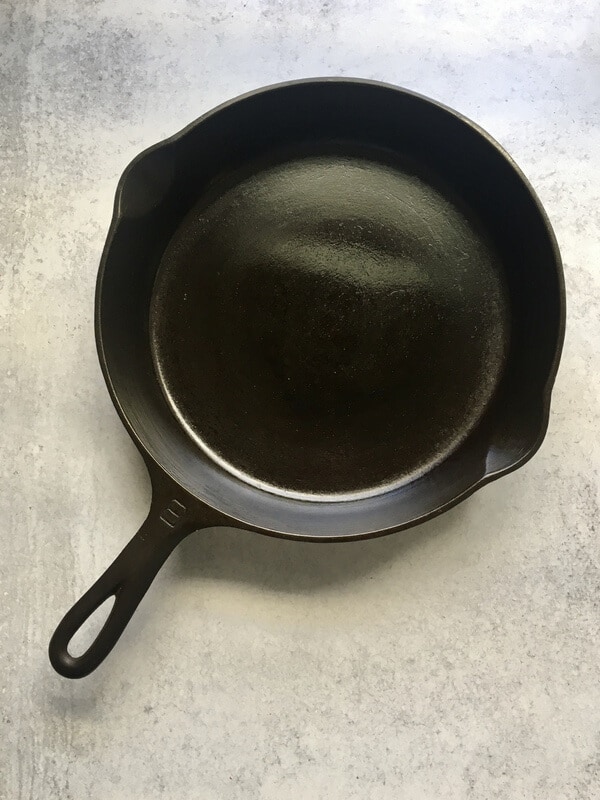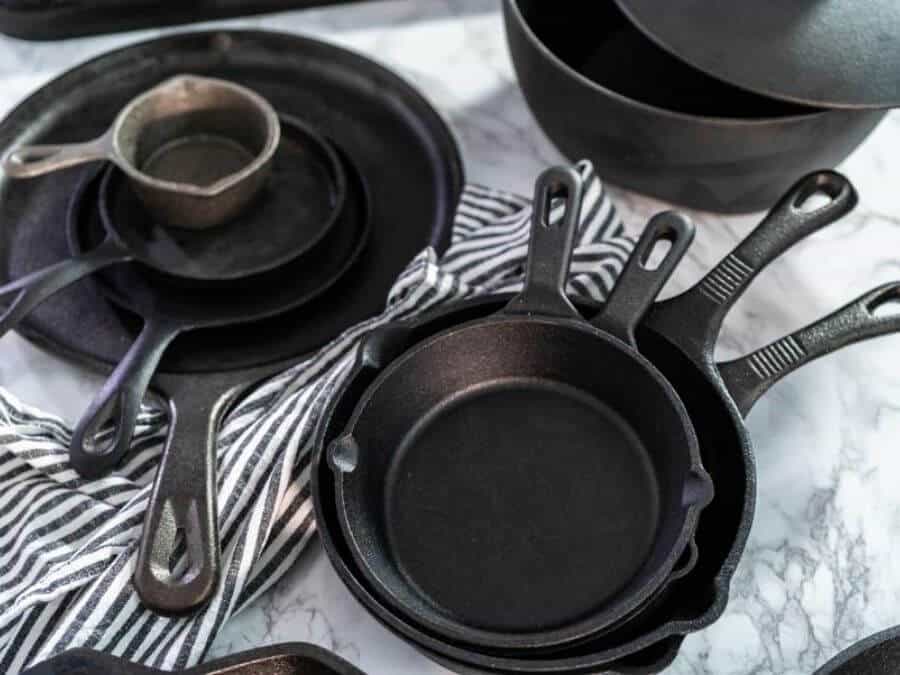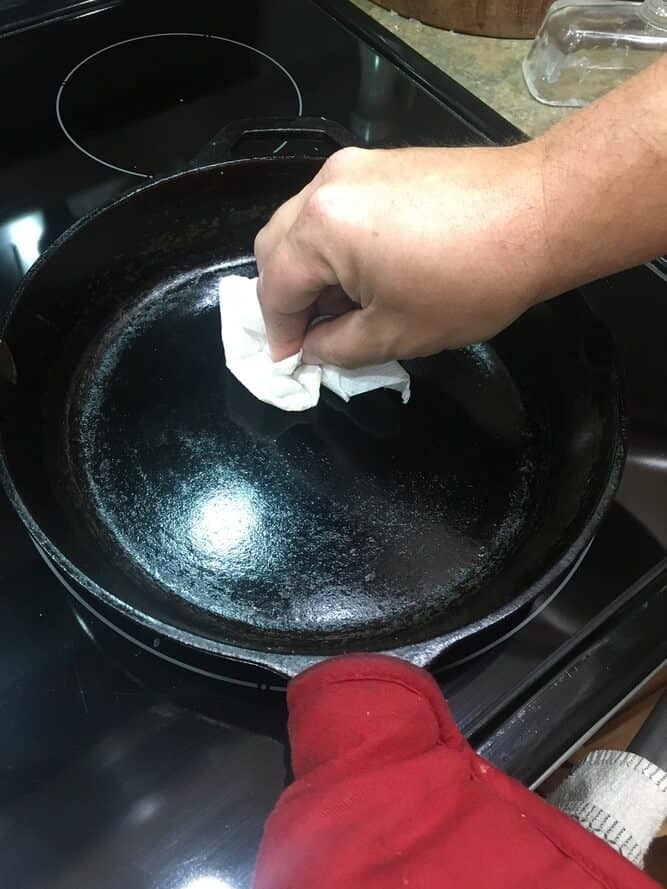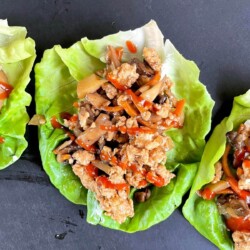What oil should I use to season my cast iron skillet? That’s probably one of the top questions that cast iron newbies ask. Right behind, how do I season a cast iron skillet? And if you’re wondering about the best oil for seasoning cast iron, then I’m here to help!
I just bought a new nonstick Teflon skillet. The nonstick layer of my old one was beginning to scrape off, and I was starting to find little black specks in my food. No bueno! Even though I only used silicone utensils in the skillet, and I took care to not clean it with harsh scrubbers, my nonstick skillet only lasted me about 1 year of heavy use.
My cast iron skillets, on the other hand, are like fine wine… they get better with age!
The oldest piece in my cast iron collection is a Griswold cast iron skillet (which I recently restored here), and at about 85 years old, it’s still going strong.
You see, that’s one of the major benefits of cast iron cookware… if properly maintained and seasoned, a good piece of cast iron should last generations. In 50 years, your grandkids could be using the same cast iron pan that you used this morning to make breakfast, as long as you know the best oil for seasoning cast iron and the appropriate seasoning method to choose, .
But first, let’s talk about WHY seasoning cast iron is so important:
What is “Seasoning” on Cast Iron?
The “seasoning” on cast iron refers to the layer (or layers) of baked-on oil or fat that protect your skillet and create a nonstick surface.
Many cast iron skillets that you purchase (like those from Lodge) will come pre-seasoned, meaning that the manufacturer has put the pan through the seasoning process, so there is at least one layer of seasoning already baked on the pan. But, for optimal performance, you should still season your brand new cast iron pans before cooking with them.
But don’t worry! The seasoning process, though time consuming, is very simple! Read my full post on HOW to Season Cast Iron… I go into detail about the 3 different methods for seasoning cast iron, and the benefits of each method.

The Science Behind Cast Iron Seasoning
The actual “seasoning” on your cast iron cookware is developed through a process called polymerization. Polymerization occurs when the right oil or fat is heated in a pan at high enough temperatures to form a hard black surface on your pan.
Certain fats are better for polymerization, which is why it’s important to choose the right oil for seasoning your cast iron.
Why is Seasoning Cast Iron Important?
Before we get into the best oil for seasoning cast iron, let’s talk about WHY the seasoning process is so important.
The whole purpose of seasoning cast iron is to protect the surface of the cast iron piece from rust, and to make it become nonstick and versatile. A properly seasoned cast iron pan can be used to bake a cake, sear a steak, and make the best over easy eggs, and you shouldn’t need to do any sort of scraping to remove stuck-on food afterwards.
Seasoning cast iron can also save you money! Unlike Teflon or other nonstick pans, the surface of your cast iron can be “fixed” so that you don’t need to buy a new pan every time that your seasoning scrapes off. The seasoning on cast iron is renewable, meaning that when your pan starts to develop spots where your food sticks, you can just apply a fresh layer of seasoning to extend the life of the pan.
What Makes a Great Cast Iron Seasoning Oil?
When choosing an oil to season cast iron, there are a few factors that you need to consider:
High Smoke Point
An oil’s smoke point is important, because that is the temperature at which the oil starts to smoke and break down. The most effective temperatures for seasoning cast iron are between 400-500 degrees, so you need an oil with a high smoke point to withstand those temperatures.
Also, if you cook at high temperatures, like for instance when you sear the perfect steak in your cast iron skillet, you will want to use a seasoning oil with a higher smoke point.
A good rule of thumb is to always choose a seasoning oil with a higher smoke point than the temperatures that you will be using for cooking. For instance, if you’ll be using your skillet to sear at a temp of 400 degrees, don’t choose an olive oil with a smoke point of 350 degrees to season your skillet.
Higher Concentration of Unsaturated Fat
Unsaturated fats have a chemical makeup that is more optimal for polymerization, the process that needs to occur to develop the perfect cast iron seasoning. So steer clear of oils with a higher concentration of saturated fats, like coconut oil and palm oil.
Neutral Flavor
You don’t want the food that you are cooking in your cast iron skillet to take on the flavor of the oil you used for seasoning, so look for an oil that is neutral in flavor.
Also, a neutral flavor oil is going to be more versatile. So instead of spending money on an oil that can only be used for one purpose, you can buy a good multipurpose neutral flavor oil that can be used for making salad dressings, sautéing vegetables, AND seasoning your cast iron. To me, that’s bang for your buck.
Affordability
You don’t need to spend a fortune to buy a good cast iron seasoning oil. In fact, my two favorites are less than $9 for 16 ounces. And if you use your cast iron cookware frequently, then you’ll probably want a more affordable seasoning oil.

What Cast Iron Seasoning Oil Do the Manufacturers Recommend?
There are 4 main cast iron cookware manufacturers, and their recommendations for the best oil to season cast iron are pretty similar. Let’s take a look:
| Cast Iron Manufacturer | Recommended Seasoning Oil |
|---|---|
| Field Company | “We recommend using grape seed oil for oven seasoning.” |
| Lodge Cast Iron | “Based on availability, affordability, effectiveness, and having a high smoke point, Lodge recommends vegetable oil, melted shortening, or canola oil.” |
| Smithey Ironware | “We use a pure grape seed oil to season our skillets. However, any off-the-shelf vegetable oil or shortening will do just fine as a seasoning oil.“ |
| Stargazer Cast Iron | “We recommend using an oil with a high smoke point such as canola, grape seed or sunflower.” |
So, as you can see, the general consensus is grape seed oil, but overall the smoke point of the oil and the types of fats they contain are the most important factor when choosing the best oil for seasoning cast iron. You can go here to read more about different cooking oils and their smoke points.
The BEST Oil for Seasoning Cast Iron – My Favorites!
Avocado Oil
Smoke point: 500-520 degrees
I’m listing avocado oil FIRST, because it is the best oil for seasoning cast iron, in my opinion! Just be sure to look for a refined avocado oil, because the smoke point will be much higher (around 500-520 degrees) than an unrefined version.
The avocado oil that I have been using for YEARS is by Better Body Foods, and it has a smoke point of 500 degrees. I get it on Amazon for about $8.00 per bottle, so it is a fairly good value.
I also prefer the avocado oil for seasoning cast iron because of its versatility. I don’t like to spend money on cooking products that only have ONE use, and avocado oil is neutral in flavor and a healthier oil, so I use it in all of my cooking. I even use it to season and maintain my Camp Chef flat top grill.
Crisco Solid Shortening
Smoke point: 490 degrees
Crisco solid shortening is a popular cast iron seasoning oil because it is versatile, affordable, and widely available in grocery stores. The solid Crisco shortening (the kind that comes in a metal tub) also has a high smoke point of 490 degrees.
When I first started out with cast iron, I used Crisco exclusively to season my pans, and it worked great. I only made the switch to avocado oil because of the health benefits and versatility. But if you’re looking for the best AND cheapest oil for cast iron seasoning, then you can’t go wrong with Crisco.
Grape Seed Oil vs. Avocado Oil
As mentioned above, 3 out of the 4 cast iron manufacturers recommend grape seed oil…. so why do I prefer avocado oil? Let’s take a look at the chemical compounds and health benefits of each:
| Oil Characteristics | Avocado Oil | Grape Seed Oil |
|---|---|---|
| Smoke Point (refined versions) | 520 degrees | 420 degrees |
| Fatty Acid Composition: | ||
| Saturated Fat | 12% | 10% |
| Monounsaturated Fat | 70% | 16% |
| Polyunsaturated Fat | 13% | 70% |
| Flavor | Mild | Mild |
| Average Price Per Oz | $0.40/oz | $0.25/oz |
Health Benefits
In recent years, the health benefits and effects of heating grape seed oil have come into question.
Grape seed oil has been touted as a “healthy oil” for years because of its high levels of omega fats. However, some grape seed oils may also contain “potentially harmful levels of polycyclic aromatic hydrocarbons (PAHs), which are known to cause cancer in animals.” (Healthline.com)
Overall, research on the effects of grape seed oil on your health is lacking, so you’ll need to form your own educated opinion on this one.
Heat Resiliency
As you can see from the table above, the main difference between avocado and grape seed oil is the fatty acid composition. Grape seed oil contains a high concentration of polyunsaturated fat, while avocado oil has a higher concentration of monounsaturated fat… but why does that matter?
It all comes down to the degradation when heated.
Polyunsaturated fats like those found in grape seed oil have been found to produce toxic compounds (including those that cause cancer) when heated. Saturated and monounsaturated fats, on the other hand, are more resistant to heat degradation.
Both oils contain a high concentration of unsaturated fats, which are better for polymerization than saturated fats, but given that the jury is still out on heating polyunsaturated fats, I’ll just stick with my trusty avocado oil.
Bottom line, you use your own judgement when choosing the best cast iron seasoning oil for you.

Other Fats and Oils for Seasoning Cast Iron
While avocado oil and Crisco are my favorites, it all comes down to personal preference. In fact, opinions on which oil to use are as varied as the oil choices themselves. One cast iron fanatic will tell you to only use bacon fat (and why you’re dead wrong if you don’t!), while another “guru” will swear by flaxseed oil and shun anyone that thinks differently. Ultimately, it all comes down to what works best for you.
Here are some other popular oils for seasoning cast iron:
Vegetable and Canola Oil
Smoke point: 400-450 degrees
We only use vegetable and canola oils for deep frying and baking cakes and brownies, but many people use these oils to season cast iron. Even Lodge’s own Seasoning Spray Oil is made of 100% canola oil. The relatively low price and decent smoke points of these oils make them popular choices, but there are better seasoning oils out there, in my opinion.
Flaxseed Oil
Smoke point: 225 degrees
Flaxseed oil may be recommended by some cast iron “gurus” because it is considered a “drying oil”, meaning that it “dries hard” to cast iron, but I would not recommend it for seasoning.
First, it’s on the expensive side. Second, the more widely available unrefined version has an extremely low smoke point. Third, you have to be careful to choose the correct variety, as many people complain that certain flaxseed oils will flake off after seasoning. You definitely don’t want to go through the multistep process of seasoning your cast iron pan only to have all of that hard work just flake off, so this oil is low on my list.
Olive Oil
Smoke point: 465 degrees for light/refined, 325-375 degrees for extra virgin
Olive oil is another popular choice for seasoning cast iron because most people probably already have it in their pantry. However, extra virgin olive oil has a relatively low smoke point, so heating it to higher temperatures will cause it to break down and turn rancid. If you are going to use olive oil, look for a light or refined version, but there are still better options.
Olive oil may be great for making salad dressings, but I would NOT recommend it for seasoning cast iron.
Bacon Fat and Lard
Smoke point: about 370-375 degrees
Bacon fat and lard have been used for seasoning cast iron for decades, probably because that was the only thing available. When our great grandparents were cooking with cast iron, they couldn’t just go out to their backyard and pick a dozen avocados to expel oil from. And they definitely couldn’t just add a bottle of specialty oil to their Amazon cart.
So animal fat was king. And while there’s nothing wrong with using bacon fat and lard for seasoning cast iron, it was widely used by chuckwagon cooks for decades, the high levels of saturated fats do not create the optimal conditions for polymerization. Plus, modern technologies have brought us much better options.

What NOT to Use for Cast Iron Seasoning
Coconut Oil
While the popularity of coconut oil is on the rise because of its health benefits, it should NOT be used for cast iron seasoning. Coconut oil has a super high concentration of saturated fats, making it difficult for the polymerization process to occur. In fact, if you choose to use coconut oil, you will probably find that your seasoning will not be near as durable as other oils.
Bottom line, use coconut oil to moisturize your skin, NOT to season your skillet.
Butter
Every household probably has butter, and you can even buy it in some gas stations. But just because it’s readily available and cheap, doesn’t mean that you want to season your cast iron with it.
Butter is high in saturated fats, which remember are not as good for the polymerization process, and it burns at about 250-300 degrees. In fact, how many times have you heard someone say that if you’re going to cook with butter in your skillet, then you also need to add some oil to raise the smoke point and prevent the butter from burning. Case closed.
In Conclusion
In conclusion, oil and cast iron cookware go together like peanut butter and jelly… you can’t have one without the other. And since selecting the right oil is such an important part of the cast iron seasoning process, you need to do your research.
Science tells us to look for oils with higher concentrations of unsaturated fats and high smoke points. I personally have had great success with avocado oil and Crisco solid shortening, but the choice is yours. Just be sure to apply very thin layers of whichever oil you choose, and heat your pan past the oil’s smoke point.







Comments & Reviews
Mike Gardner says
I was given a bottle of Pecan Oil. The smoke point is 470°F. It is 52% monounsaturated oils and only about 12% saturated fats (wiki).
Is it suitable for seasoning cast iron skillets?
Thank you
Buru says
Nice article. Like you, I exclusively use avocado oil. I have not seen your “rust removal” article but noticed it mentioned several times that a lye bath is common or recommended so thought I’d share my method. I use a rust removal grinding disk on a portable drill. After rust is removed ~2 minutes or less, I smooth out the surface with a 400 grit sanding ball…. Again 2 minutes. This method actually turns the black cast iron silver. To season I heat pan on stove top between 200`300 degrees and apply a thin layer of avocado oil then oven @400 for an hour. I remove from oven and apply another thin coat and back in oven for another hour. This process actually turns the silver pan a beautiful gold color as the oil poylermizes. Over easy eggs are now a breeze on the gold colored seasoning, and the clean up is simply a wipe down with a paper towel.
William Dulasky says
I have a large collection of cast iron, and have been using eather veg oil or crisco shortening. My question to you ( and I think you should share your answer ) is , if I want to switch up to the avicado oil will I have to remove the current seasoning or can I apply the avicado layer over it ? Your video was very help full thank’s .
Andrew says
“Just be sure to apply very thin layers of whichever oil you choose, and heat your pan past the oil’s smoke point.”
Shouldn’t that read “…and DON’T heat your pan past the oil’s smoke point”? Or if it was correct as written, why and when should we heat the pan past the smoke point?
Andrew says
OK so now reading some of the other comments, I’m wondering if I’m supposed to heat my cast-iron past the oil smoke point BEFORE I then season it. Is that correct? This isn’t a new pan, I’ve been using it for a number of years and I’ve probably been seasoning it with the wrong oil, but now I’m wondering if I’ve also been seasoning it improperly by only getting it warm enough for the oil to melt into the cast-iron.
So I guess the other question now is: after I use the pan and it’s time to season it before I put it away for the next use, do I heat the pan in the oven past the oil’s smoke point, then take it out and carefully season it with my Crisco or avocado oil?
Julian T says
Refined olive oil has a higher smoke point than canola oil. And similar to Avocado oil, refined olive oil is healthier than seed oils. So why wouldn’t you recommend refined olive oil for seasoning cast iron?
RP says
just curious about pecan oil. it passes the temp test and has some unique health benefits. (high ellagic acid content) dk what heat does to it though.
Jim Glatthaar says
Excellent and informative post.
Sandra says
I seasoned my cast iron pan, but they are not smooth. What did I do wrong? They feel rough the oil was spotty.
Tanya says
I have found that if I use too much oil then it will be rough and spotty. I apply a very thin layer of oil and then wipe any excess off with a dry towel. if it’s capable of running its too much oil. I also coat & bake 3 times (but I only use my cast iron to cook so it gets used daily)
Rupesh says
I bought some refined avocado oil. It’s not that readily available in the UK. I was wondering what temperature you season cast iron with it?
Tanya says
I use avocado oil and season mine at 400°. seems to work for me!
Falfiee says
Is thete a seasoning oil that won’t cause the cast iron to smell rancid if it’s not used for a couple days?
I’ve been using vegetable oil & storing it in my oven, but after a couple days of non use, it smells rancid.
Kris says
If it smells rancid, it’s probably not polymerized properly.
Stephen says
Good methods…I use grape seed oil as well on my high temp cooks. Use Crisco solid on my cast iron.
Mary Lou Hicks says
I have a cast iron skillet I received way back in 1953. I still use it. I didn’t know anything back then about seasoning the pan and I never did. However, I have always kept it oiled and clean. Each time after using it and washing it I would heat it up a bit on the stove top and oil it on the inside before storing it, probably using all kinds of oils over the years. So here I am all these years later wondering what I should do at this point, shall I properly season the skillet as it is? Does it matter about all the oils I have used in the past?
Falfiee says
If it’s not broke don’t fix it
Denine Boyle says
Question: If I use solid form of Crisco..do I melt it first or just spread it all over?
Neal says
I just spread all over and let the heat melt it…
Andrew says
I just read this column today (1/19/24) and 10 minutes ago used solid Crisco for the first time and wondered the same thing, so I just applied it directly and I’ll be darned if it didn’t melt beautifully! So I used it on the entire pan even the outside!
Alex R. says
I have a cast iron that I have been seasoning with bacon grease for the past several years. It’s fine, but I want to level up. can I season over the existing seasoning? Or do I need to scour it out and start from scratch?
Neal says
Thats a tuff question. I will be honest on this one..I am not the smartest but try to study this issue alot..still can not relay the information correctly. Bacon should not be used for seasoning. Can it help yes…when its comes to seasoning its about a certain fat that burns and creates a patina. In the old days the did not have the technology we have today about oils and science so the the history for some has not changed, just like cleaning cast iron with soap. Technology changes but the history has not. Soap today is different and can be used to clean cast iron. Just like bacon these old timers were using the few pieces of cast iron every single meal every single day. So no many people do that today and if they did I am sure they have more pieces of cast iron in their collection….Thus bacon fat was used a lot and did its job. Nowadays its about a few oils that I highly recommend. Grapeseed, Avocado oils and lard Crisco.
Falfiee says
By lard Crisco, do you mean solid? Does it matter if it’s original or butter flavor?
Nancy Lee Campbell says
This is wonderful information!! I just bought a Cast Iron Casserole pot, 4 qt. & haven’t seasoned cast iron in over 50 years, so couldn’t remember which oils I could use. I knew not to use Olive oil but I didn’t know about Coconut oil. Thought I could use Crisco but I really love the idea of using Avocado oil as I prefer the healthiest oil to use. I never use Canola oil for anything at all, nor Corn oil either. Thank you so much for a great tutorial on oils!!
Neal says
Hey thanks Nancy…really appreciate it….how did it go for ya
Mark says
After seasoning there is no fat left. It has turned into different compounds. So the smoke point of flax at 225F does not mean that after seasoning it will burn off when you sear your steak much hotter.
However, I’m not saying flax is better. I’ve used several oils over the years and they’ve all worked pretty much.
It’s the omega 3 oils (ALA in flax) that turn into the polymer, and flax is very high, 70% compared to 10% in grape seed. So the theory suggests flax. But the proof is in the frying.
One thing I’m wondering – if flax smokes at 225f, why heat to 450F? Surely, 250F or 275F would be ample? And why a whole hour? If you accidentally smoke your oil when frying, you would have no oil or just a thick mess after 10 mins. Next time I’ll try 275F and 30mins and I’ll let you know.
Barry says
I seasoned mine 3 times with avocado oil at 490 degrees and my seasoning looks like leopard spots on the cooking surface of the pan. it’s not sticky, but it’s not uniform shiny like the pictures. The sides of the pan, both inside and outside are black and shiny. I know it’s not too much oil because it’s not gummy/sticky. What am I doing wrong?
Joe Kerr says
ah yes. for this you will need:
a medium bowl
the blood of a small goat
white linen clothes
animal masks
you will take the pan to the nearest crossroads at midnight. you will dress the goat in the linens and sacrifice it, naked. you will then wear the linens. you will put the bowl upon your head like a crown after donning your favourite animal mask. now dance to the tune of Old McDonald Had A Farm three times whilst rubbing your belly.
you won’t need to worry about seasoning your pan any more.
because you’ve been sectioned.
No says
Dammit, i didnt bring the goat, just the blood of it. I should read the instructions more carefully before entering into these schenanigans.
Connie says
I need to remove some spots of rust on a flat rectangular cast iron griddle. It is new and I did not know that I should season it . The area of rust is about the size of a quarter.
I enjoy your videos.
Janice White says
What can be done to remove rust from the removable cast iron burners on a gas top stove? My daughter used some chemical cleaner on them & let them soak in it for several hours. ( A brand new stove, also!). Thank you.
Brenda says
So if cast iron builds up the heat as it continues heating in the oven, why would you put the heat at 500ºF instead of 350ºF or even 400º?
Neal says
Cast iron will only get as hot as the oven gets,,,building heats is a term used when dials are set to low med high..no direct temp. When a skillet is on the stove and you put your stove on med heat…your cast iron will not stay at med heat…by the time your eye turns off and on the cast iron doesn’t have a chance to cool down thus building heat
Marcus says
I just had a few questions about the smoke point of avocado oil. the intent of baking it to the smoke point is so the oil can harden and polyermize as I understand it. With such a thin layer distributed on the pan, why does it take a full hour for the physical change of the oil to occur? people mention you don’t want your pens to be smoking or it will just take off all of the seasoning.
I’m just confused and frustrated as you were in your YouTube video because I’m supposed to surpass the smoke point I think but then it’s bad if I do?
let me know your thoughts
Neal says
Well not sure about other people and there are a lot smarter people than me but this is the dummy version..some oils are built different. When seasoning cast iron it’s important to BURN the oil into your pan thus creating a Black Patina. After these thin layers are done its about maintaining the seasoning throughout the life of the pan. It’s not a one time thing. Bringing your skillet up to a smoke point to sear a protein is a heck of a lot different than heating a pan up for an hour with nothing in it. Hope that helps
Matthew says
I loved your article! Thank you so much for putting this information together in such a sensible way to read and understand. I am grateful! 🙏💛 Since reading your article I’ve been strictly using avocado oil to season my cast iron. It works great!
Question:
With carnivore and animal-based diets becoming popular, and I myself am experimenting with it, I’ve discovered something I didn’t know previously existed. Tallow! Also I have heard/learned that many unfortunately many avocado oils are in someway, either in advertently or purposely, contaminated / cut with other cheaper and inferior oils, like soy bean oil. No Bueno! because of this I have started experimenting with seasoning my pans with tallow. I am unsure and have been trying to find information about the smoke point of tallow which I believe is very high but I’m not sure exactly what it is.
So, would you mind commenting on tallow? Maybe even add it to your list of options to your article.
Matthew
Matthew says
https://www.savedbythemax.com/what-is-beef-tallow/
Matthew says
I found a pretty good article about beef tallow including its smoke point…
https://www.doctorkiltz.com/beef-tallow/
Neal says
Thanks Matthew! I’ll check this out.
Neal says
Hi Matthew! I actually just bought a container of tallow two days ago, because many of my YouTube subscribers have recommended it for griddle cooking/seasoning. I’m excited to try it myself, and once I get some hands-on experience, I’ll report back.
Neal says
I am currently experimenting with it now…so far I have not been impressed both on seasoning and flavor
Paul says
I now use only avocado oil. But you must know your heat source and temps. That’s easy with a internal stove, but surface coking and gas grill temps can get and stay hotter longer. Get an appropriate surface temp thermometer. This ain’t grandma’s wood stove no more. I watched my 7+ layer flax oil cast iron bubble up, burn, and flake off. Learn from my mistake and this great article.
Neal says
So true about the internal stove temp versus surface and grill temps… It amazes me how many people recommend flax oil, so I’m glad to know that I’m not crazy, and nice to know that you recommend avocado oil also. It seems like everyone has their own personal preference, but I have had great success with both avocado oil and Crisco. Thanks so much for your comment, and the cautionary tale about the flax oil!
Karen says
I have my grandmother’s skillet and dutch oven. At one point my son put the skillet in the dishwasher, came out rusty looking. He then tried to season when visiting me, it did not work. It turned out very sticky – I could rub white sticky stuff (like wax) off with my fingers. I tried adding water and boiling – what ever oil was used foamed up at boiling point. Skillet and dutch oven are still sticky. What can I use and how can I clean it to get rid of the sticky residue so I can start all over with the seasoning process?
Reuben K says
I dont know what that substance stance is, sounds not too nice.
I’ve seen plenty of restoration videos where the iron cookware is submerged in either bath of Vinegar, Lye, or electrolysis bath.
If this would happen to me I’d try a lye bath to completely strip everything away and start over. Sad but perhaps nessesary.
Before the lye bath as a last resort I’d first try scrubbing with either salt, or barkeepers friend and maybe using a strong degreaser because at this point it sounds to me like a restoration.
You could try to leave it in a self cleaning oven cycle if you have the option.
I’m no expert though am resourceful and watched and read a ton.
If nothing works might have better luck trying to contact your great grandmother and asking her though she might not be too pleased, your call!
Best of luck!
matthew says
Another option is to completely soak it in oil (avocado or olive oil for example) and let it sit for a while because oil is a solvent and will help you scrub and remove the sticky substance. (Learned years ago that such oils are great for removing chewing gum from hair or furniture or rugs. Also helpful for removing adhesive from glass jars.) Other than that, I really like the suggestion of the self cleaning oven treatment.
Matthew
Kevin says
It sounds like you just need to strip it, scrub it and re-season it properly. I use a lye bath to strip. If there is any rust after that, then it goes to vinegar and water bath. Apply the oil of your choice and make sure to cover the whole piece. Now, here is the important part of this… Wipe off all of the oil that you applied with a dry, lint free cloth. Wipe it off like you don’t want it there. Then heat it in your over for about an hour above the smoke point. Do this at least 3 times. What happened with your pans, besides the destruction of a dishwasher, is that too much oil was used for seasoning. This will create incomplete polymerization of the oil, resulting in a sticky residue that won’t go away easily. Hope this helps. Good luck!
Ted says
Hi Colleen, I know this is from last year, but I wanted to answer about lard specifically.
I used lard to season an outdoor griddle, and it seems to have worked just fine. I cleaned the surface first, got it hot, then applied thin layers. Each layer gave off blue smoke at first, then after about 10 minutes tapered off to hardly any smoke at all…whereupon I applied another thin layer. By “thin” I mean half a teaspoon, spread over the whole surface with a paper towel and tongs.
The parts of the grill that didn’t get over hot ended up with a kind of sticky, clear coating that was gross to the touch. But after a few cooks and wipe-downs, that stickiness has hardened and smoothed out. The cooking surface was good enough to do burgers, veggies and eggs. I followed up with bacon grease the next day, and did an “old school” seasoning by just leaving some of the grease residue on until the next cook. Started the next cook by letting the surface smoke for a bit.
I got what I consider pretty good results.
Ted says
I first seasoned cast iron before the age of the internet, when word of mouth from relatives was all you had. I guess people now know better, so can do better. But the old ways still seem to work.
Having recently bought the Camp Chef 600 griddle, I had a seasoning session just a few days ago. I took the surface down to a clean smooth texture, then let the griddle heat up on low, switching over to medium-low after 15 minutes. I used about 4 thin layers of lard, let each smoke off in turn. Cooked burgers on it that evening, was able to harvest all the crust on the meat.
Next morning, cooked two packages of bacon and let most of the grease stay on afterwards. When I wanted to cook later in the day, I let it heat up to the smoke point of whatever bacon fat was left on there, then I started using avocado oil for cooking. Wife insists on olive oil for veggies.
By day 3, we ended up with a nice dark brown/black glossy surface. Wipes down clean with paper towels after cooking. No stickiness with eggs.
Cast iron is cooking with a soul, glad there is so much info available these days, and people appreciate it.
Gina Audi says
So after reading all this wonderful information I now have a dilemma.
I just restored a few cast iron skillets in a lye bath. They came out beautiful. I decided to go with flaxseed oil for the seasoning. I’ve done two rounds of it already. But after reading your article about how flaxseed seasoning may flake off and how food might stick more to it, I’m wondering if I should season them a couple of times with avocado oil instead and should I go right over the previously done flaxseed oil seasoning or should I just put the pans in a lye bath and start all over again?
Any advice would be greatly appreciated 😊
CastIronEarl says
6 sessions of :
– heat pan to 200
– apply flaxseed oil and wipe off as much as possible
– one hour at 500 degrees
Create a great foundation
Then fry potatoes twice in canola oil with a session like the above after each cook
Then two sessions of bacon repeating the sessions above
Had given me a very good foundation
Reuben K says
I’ve actually got a good glossy hard seasoning on my stargazer by simply stove season it.
I basically just rubbed the paper towel with residual flaxseed oil all over the pan again and again, rub, smoke repeat until the paper towel fell apart.
Needless to say I dont recommend flaxseed oil either, its flaked off and I’m steering clear of that one from now on.
Neal says
Thanks for the comment Reuben!
Geoffrey says
So far I have only used flax oil and found that has mentioned some brands (? ) Do you tend to flake off. The Lodge company who I contacted Told me that flax would likely cause food to stick and I should use vegetable oil or canola oil. I have had some issues with food sticking from flax.
I don’t think the “health benefits” of the oil make any difference at all once you’ve gone past the smoke point. Once you’ve done that it’s basically plastic
m.c. says
A better value than smoke point is really iodine number – that puts coconut oil back in the running too.
James says
I’m doing the five seasonings process right now, can’t wait until it’s done. I was just wondering how to clean cast iron after it’s been seasoned?? Soap and water, just water, or something else?
Neal says
How you clean your pan after using it largely depends on what you cooked. If you’re cooking a grilled cheese or quesadilla, you don’t really need to wash it. You can simply take a paper towel and wipe it out. If you’re making spaghetti sauce, gravy, chili, or something that gets your pan dirtier, then you can rinse it with warm water – Make sure to match the temperature of your water with the temperature of the pan, so that you don’t damage the pan. For instance, you wouldn’t want to add cold water to a hot skillet. You can wash it with soap and water every now and then if you want… it’s a myth to never use soap on cast iron. It’s all about the re-seasoning process.
Kate says
I need to know how long and at what temperature do I season my skillet on top of the stove? And how much canola oil in the skillet?
Reuben K says
I agree about not using soap as being a myth and non harmful to the pan however I do find that it leaves a smell that I dont find pleasant, might just be the liquid dish detergent I’m using.
Have you experienced this smell issue?
Neal says
What type of dish soap do you use? I pretty much only use Dawn, and I’ve never really experienced any sort of smell afterwards. But I also only use soap rarely if needed after cooking certain foods.
Aimee says
Hello, I used Dawn for my first wash of my new pre seasoned cast iron. I’m in the process of seasoning now and just wonder if Dawn was too gentle for my first wash? I used my chain scrubber and Dawn.
Steve Bridge says
Author: I think you’re missing the point, chemically speaking. the ‘smoke point’ is only an issue when you are cooking. When you ‘season’, you are taking this thin coat of oil and PURPOSEFULLY taking it past its smoke point… at THIS POINT – no matter the type of oil, it becomes a polymer. The question is, AFTER you reach polymerization, at what temperature does it degrade. Has NOTHING to do with ‘smoke point’ at that point because its chemically a different substance… it is no longer oil.
Focusing on ‘smoke point’ means you are missing out on the science of what polymerization does for you.
Colleen says
I do prefer to use lard, but I haven’t found the best way to build a solid seasoning. Any suggestions or methods for working specifically with lard?
Steve Bridge says
I think if you insist on working with lard, you will not have the success that you are looking for.
1. Take your oil of choice and apply THINLY to the pan (by fingers – that’s the best)
2. Take temperature up to just past the smoke point for that specific oil that you are using, and let it smoke until it smokes no more.
3. Remove from heat, let cool. There should be no more oil in there at all.
You have now created a thin, polymerized coating in your pan! Several coats are much more effective.
Note: The reason flaxseed oil is so good for making a polymerized coating is not because of the smoke point – nothing to do with it (in fact, flaxseed oil has a very low smoke point), The value is in the strength of the polymerized coating… which has something to do with the ‘double-carbon bonds… chemistry stuff).
To illustrate how little the smoke point has to do with the quality of the resulting polymerized coating, Grapeseed oil is 2nd in preference for quality of polymerization… and its smokepoint is 400+ degrees.
Hope the perspective helps! Kindest regards.
Hawaii.heaven says
LOVE this. Thank you.
Neal says
Thanks so much… Glad you found the info useful!
TucsonTerry says
Thank you! This is the clear and detailrd explanation that I have been looking for.
Lane Gray says
No mention of ghee, with its smoke point of 482F?
Neal says
Honestly it was a rabbit hole I was trying to avoid. I actually have ghee and used it in some of my camp chef flat top videos. Shortly after I switched to avocado oil and have not looked back. When doing reviews I try to do/talk about things I personally have used to produce a opinion about. That being said I couldn’t pull the trigger on ghee.
Have you used ghee. If so is that your #1 option.
SW says
Thank you for this informative post. Based on manufacturers recommendations and reader feedback, I will be looking at grape seed oil.
Neal says
Awesome, let us know how it goes!
Sandra says
I have a griddle that goes on my new Camp Chef Grill that needs seasoning. I’ve been wondering about ordering a special product for that purpose, but when I found your article I agree with you. I do have avocado oil and I use it a lot. I’m glad to hear that you recommended it so that solves my problem. Thank you so much for your help!
Neal says
That’s awesome Sandra! No need to buy something new if you don’t have to… I pretty much exclusively use avocado oil to cook with and to maintain the seasoning on my griddles. You can also try Crisco for seasoning… it’s inexpensive and you may already have it in your pantry.